Bonsai species

Bonsai can be defined as a "potted tree." Art originated as early as 200 BC. NS. in China. Several centuries later, the inhabitants of the Land of the Rising Sun brought it to full perfection, so the technique is considered to be truly Japanese today. Bonsai serves as an original and expensive decoration for any interior.
Popular styles
For many years, the cultivation of dwarf trees was widespread mainly among the poor, and only at the end of the 18th century did this art become an object of close study. Several pretty interesting bonsai styles have been created. Miniature tree arrangements are very popular these days. They are not just a houseplant, but a miniature copy of a representative of the flora. There are trees with strong branches and powerful trunks, flowers and fruits. Roots become an indispensable part of the relief, and for a greater resemblance to the forest landscape, sphagnum and stones are used.

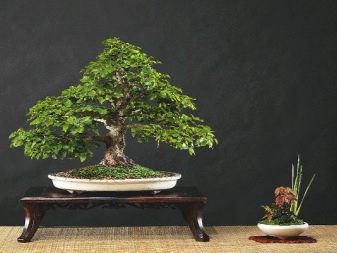
There are several basic styles in which the tree is grown.
Upright correct
This is the most common bonsai style. The tree is distinguished by a rather straight trunk, which gradually tapers upwards. The roots are thickened, diverging, and the branches are slightly inclined. The top is usually made in the form of a spherical or conical shape. This bonsai looks best in oval pots. The design of the barrel in this technique is the most important. It is visually divided into 3 parts. The lower one is completely without leaves and branches, so that the trunk, rhizomes and bark texture are clearly visible. Branches extend from the middle part of the trunk.
Two of them go to the sides, and the third rushes to the center of the composition being created: such a solution enhances the sense of perspective. This branch is considered to be the main one, it must certainly be with leaves and have a beautiful shape.

Wrong upright style
Its characteristic feature is a curved barrel. For the perception of the composition to be panoramic, the crown must be turned towards the viewer. All other elements: branches, leaves, roots, are arranged in the same way as in the correct upright style.
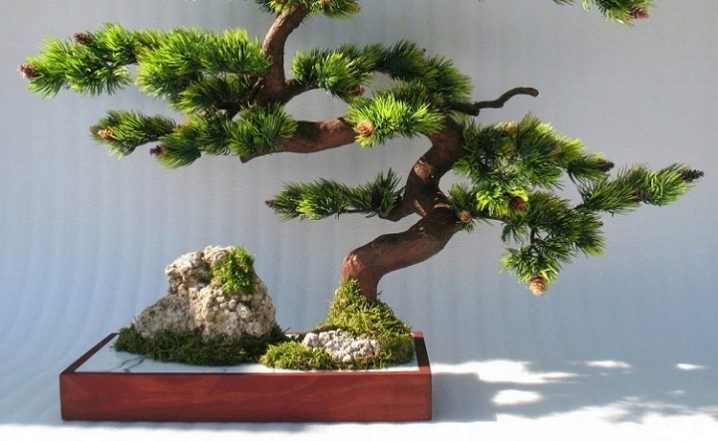
Tilted tree
Usually, in this case, the tree is bent and tilted slightly in one direction. At the same time, the branches are bent towards the slope of the trunk, and its upper part looks forward.
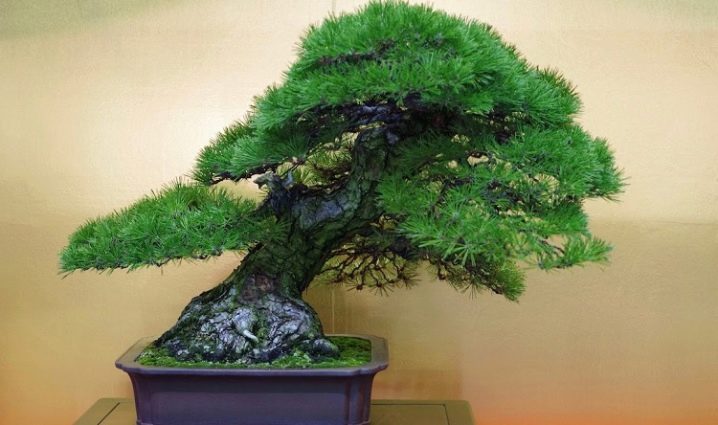
Tree bent by the wind
The definition itself provides a description of exactly how your composition should look. The slope must have a specific direction. The side from which, according to the author's idea, gusts of wind are blowing, may not have branches.
If there is a branch, it is directed in the same direction as the rest of the branches.
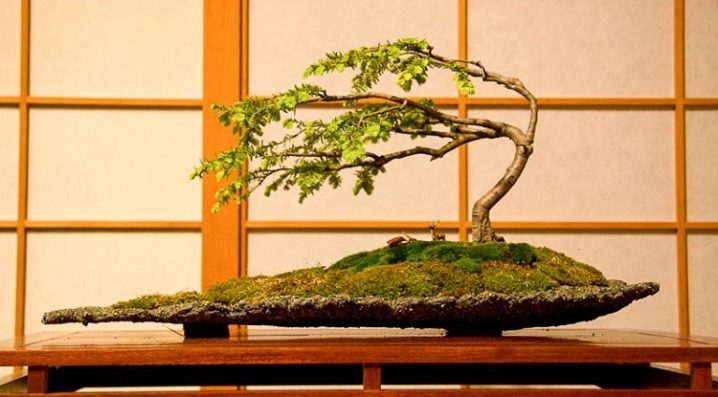
Cascade and half-cascade
The semi-cascade technique is often called “tree on a rock”. The trunk is directed upwards at first, and then suddenly and sharply bends to the side. In a cascade, its branches hang just below the level of the flower pot. To enhance the impression, such a tree is placed on the edge of the desk or on another elevation. All 3 main branches should be clearly visible on the back of the cascade.
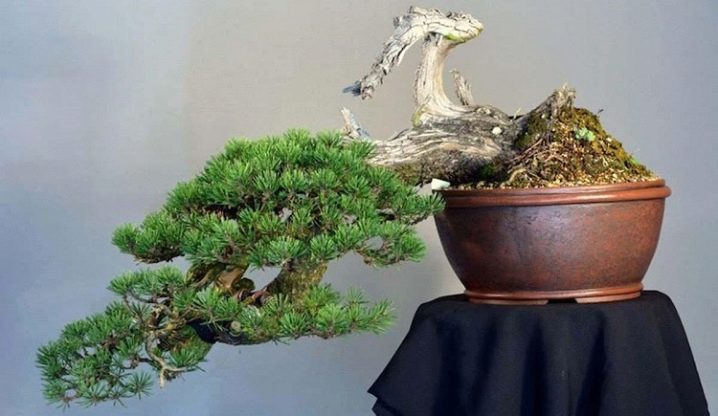
Broom tree
The plant resembles a panicle: it has an erect trunk, and all branches are raised up.

Bunjin
This is an elite style. A distinctive feature of bunjin is a special bend of the barrel. It looks elegant and sophisticated, literally embodying all the best aesthetic traditions of Japan.
There are few leaves, but each leaf has a clear outline, which allows you to appreciate its attractiveness.
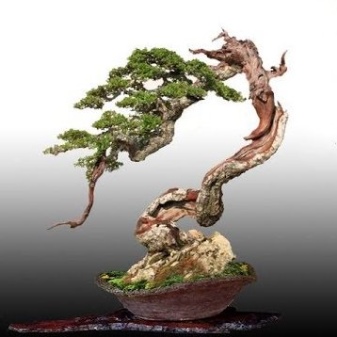
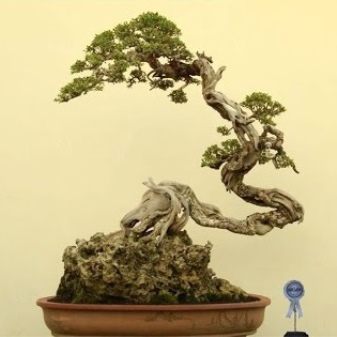
Multi-stem tree
This bonsai has 2 or more trunks, but they grow from one point.Such a composition can be performed in different ways due to the interlacing of the trunks. Their crown can be either separate or single.

Group of trees-mix
This technique involves growing from 2 trees in one pot to decorating a whole grove. In fact, the whole landscape is being recreated here, therefore it is considered an indispensable condition for the use of additional decorative elements: stones, ferns, sphagnum.
It is they who will give the overall composition completeness, conceptuality and flavor.
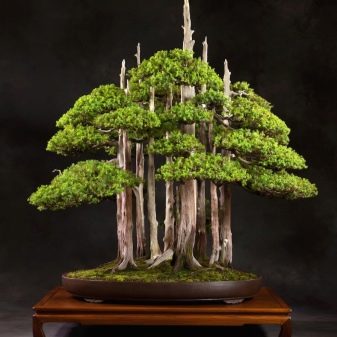
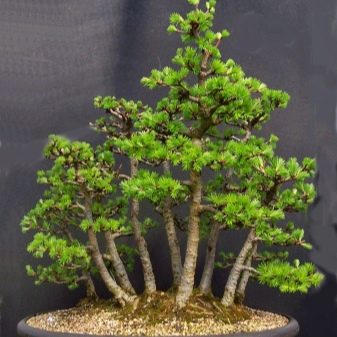
Bonsai on the rocks
An indispensable attribute of such a technique is stones. As a rule, the composition is performed in the form of a rock, which is braided by roots, and it looks quite impressive. The tree has a clearly defined trunk, branches and crown. Such compositions are naturalistic.
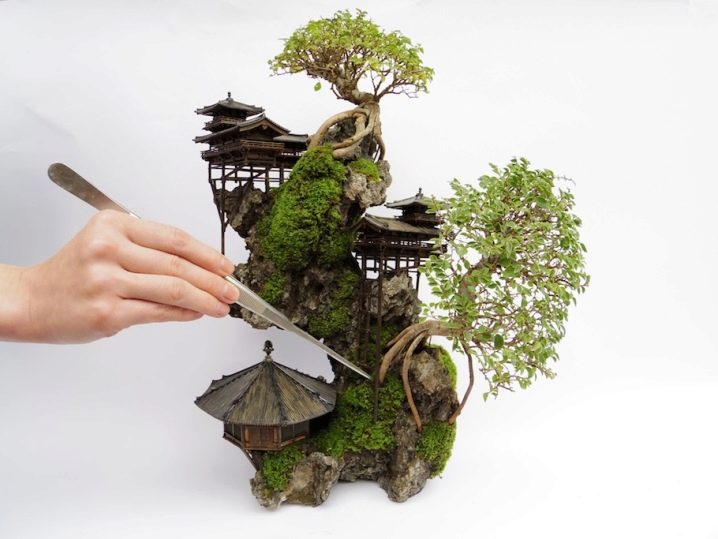
Features of the species
Depending on the size of the composition, there are 5 types of bonsai.
- Mame... Translated as "tiny". This includes plants whose size does not exceed 20 cm. These are dwarf trees, they are often grown in jars.
- Sekhin... Bonsai up to 25 cm in size.
- Kifu... Medium-sized plants grown to a height of 25 to 40 cm.
- Tyukhin... Quite large trees, their length reaches 120 cm.
- Daiza... Huge trees are hidden under this definition, they include all bonsai with a height of more than 120 cm.

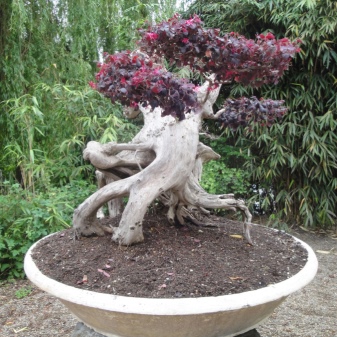
Depending on the number of trunks, species are also distinguished.
Single-barreled
It has one root and one trunk. This option is considered the most common and serves as the basis for creating a wide variety of styles.

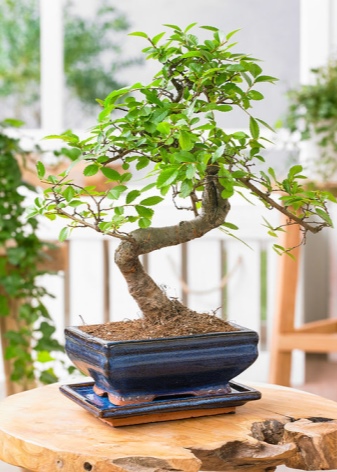
Multi-barreled
In this case, several plants grow from one root at once. Rarely, but there are compositions when several trees grow in one container with their individual roots.
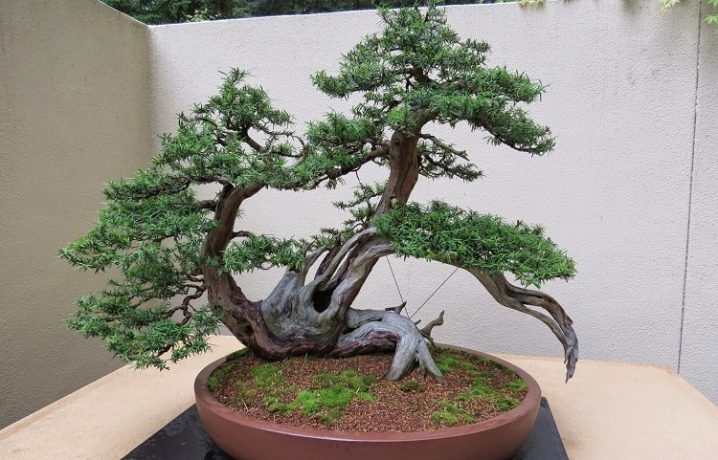
Several options are distinguished depending on the flowering time.
Evergreen
Most of the plants belong to this category, they look very impressive in the home interior, create an atmosphere of grace, sophistication and comfort around them.
The most commonly used are conifers.

Blooming in spring
They fully reveal their beauty in springtime, bringing the sensations of light, sun, warmth and the awakening of nature to homes. Fruit trees are especially good.
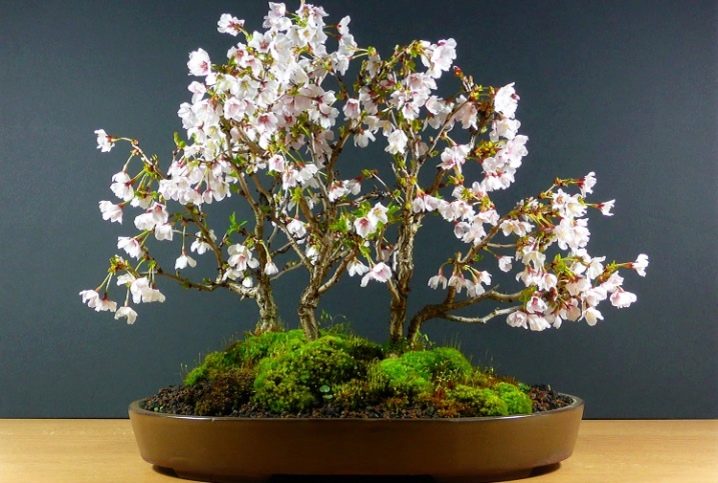
Blooming in summer
Such bonsai delight their owners with abundant flowering in hot weather, in harmony with the surrounding nature outside the window.
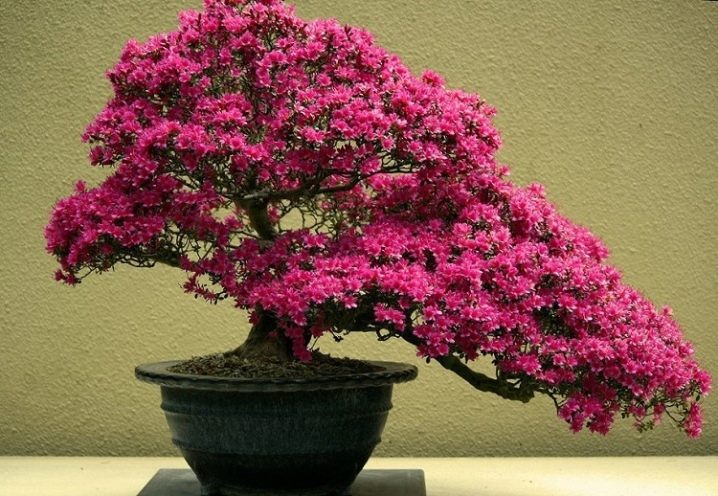
Blooming in autumn
At a time when the colors are fading on the street, a riot of colors and freshness reigns in the house, bringing a touch of romance and charm to every home.
Mini-trees look very impressive, in which the foliage is painted in bright colors in the fall.
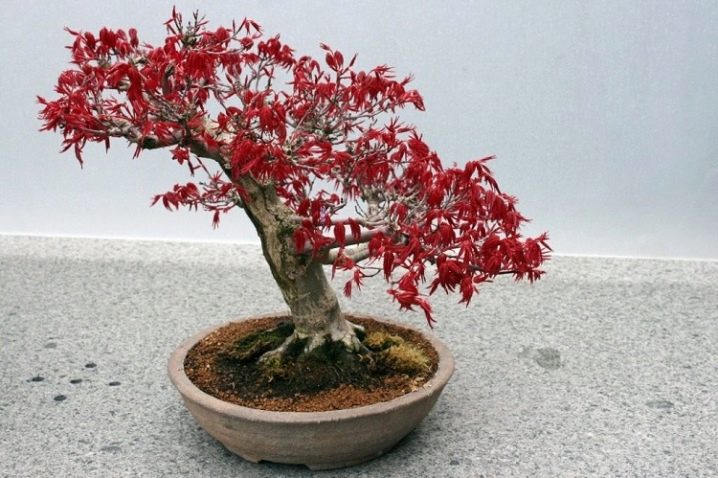
What plants are used?
When choosing an optimal crop for growing bonsai, you need to keep in mind that the length of the leaves should be quite small, the flowers should also not be too large, since they will look disproportionate on a miniature plant. From conifers, preference should be given to juniper. This shrub is considered ideal for the formation of bonsai: it is distinguished by its endurance, is able to take any shape. However, it grows and develops rather slowly, so you will have to wait for the result for a very long time.
Roxburgh Pine has elongated needles and is used to grow landscape bonsai cultivated in the garden. However, if desired, it can be trimmed to the required size and create a compact version of the tree. Fir, spruce and yew are easily formed. Of deciduous trees, mulberries are the most suitable for growing in the bonsai technique: they are characterized by the ability to take the necessary shape. In addition, they grow quite quickly, therefore, within a few years they have been transformed into a rather interesting bonsai.
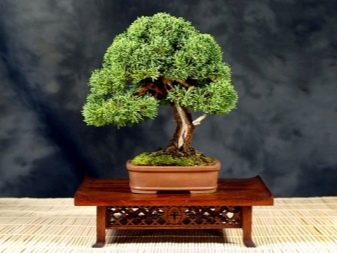
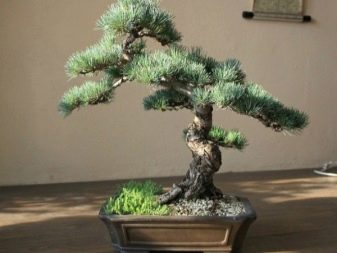
Ficuses, for example, Bengali, look especially stylish. It gives pronounced ground roots and a thickened trunk, which takes a columnar shape over several years and occupies a rather impressive area.At the same time, foliage begins to shrink over time. These qualities allow you to create the correct bonsai in terms of growing technique. Camphor laurel, as well as oak, lend themselves well to growing and shaping.
Among deciduous trees, it is worth noting several varieties of maple, alder, hornbeam, as well as birch, weeping willow, from which a rather spectacular decorative bonsai can be grown. Some varieties of apricot, peach or plum look good in this technique.
It is noteworthy that they bloom before the leaves appear, so this bonsai looks especially interesting in the spring.
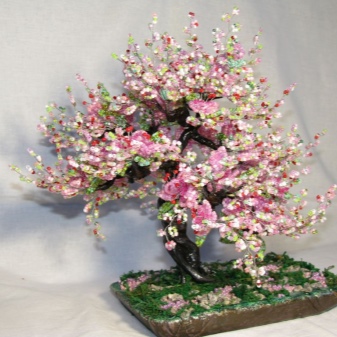
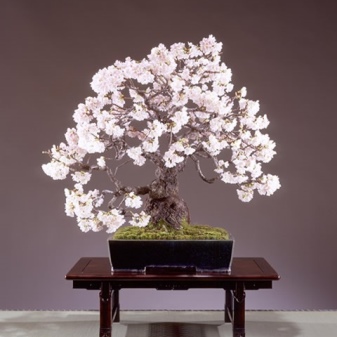
Japanese pear, apple and almonds can also be used to create a composition. In our climatic conditions, many varieties of cherries are suitable, as well as hawthorn. With careful cutting and crown shaping, a good bonsai is obtained from mulberry and acacia.
Among the shrubs for growing bonsai, Malpigia is most often used - a small unpretentious plant with glossy dark leaves. Malpighia stems strongly branch, and powerful roots spread along the ground. Chinese lime, muraya and cotoneaster can also give good results if the crown is formed correctly. In the bonsai style, climbing plants, for example, honeysuckle and wisteria, look quite impressive. They are grown to create compositions in the style of "cascade" or "hanging over a rock tree". Less common, but you can use bamboo.


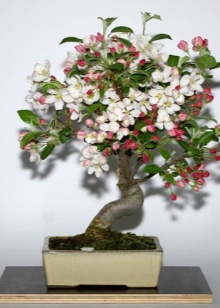
Subtleties of care
A bonsai tree needs special care. Its cultivation is accompanied by constant growth restriction, crown formation. The plant is in a limited capacity. Therefore, it is worth following some rules.
- Bonsai should be protected from drafts, and also do not put a pot with it near heating appliances.
- The roots are usually pruned before planting., then the plant is planted in a container, the roots are covered with earth and abundantly watered with thawed or settled water. After transplanting, the container should be kept in a darkened place in quarantine for 2 weeks.
- Watering should be moderate... It is desirable to carry out it by the submerged method. During the period of active growth, watering should be frequent, and in winter they should be reduced.
- Plants require fertilization about once every 2 weeks., for each type of tree they are different. In winter, bonsai needs rest, it is best to place it in a room without heating, while protecting the root system.
- The plant needs annual sanitary and decorative crown pruning. It allows you to set the necessary direction for the growth of branches and redistribute energy from strong shoots to weakened ones.

For what and how bonsai are grown, see the next video.































The comment was sent successfully.